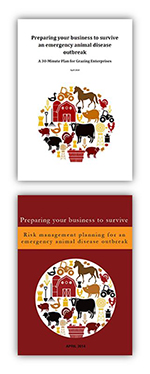Read the latest information on
Foot-and-mouth disease

Two new documents have been published to help livestock producers survive an emergency disease outbreak.
Two new documents have been published to help livestock producers survive an emergency disease outbreak.
The first document, Preparing your business to survive: Risk management planning for an emergency animal disease outbreak, is designed to assist livestock enterprises prepare a risk management plan for emergency animal disease (EAD) outbreaks. This manual can help you by:
The second document, Preparing your business to survive an emergency animal disease outbreak: A 30-minute plan for grazing enterprises, is a planning tool to assist you to develop an EAD survival plan. The plan outlines what to do if your property were infected with, or classified as ‘at-risk’ of, an EAD.
The planning process in this document focuses on four key steps:
This document outlines a plan that takes just 30 minutes to prepare. It could improve the resilience of your business if an EAD occurs. You may even discover some useful ideas for improving the every-day operation of your business. Just follow the four steps provided.
These documents were commissioned by the following Animal Health Australia member livestock industry bodies including: